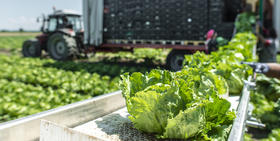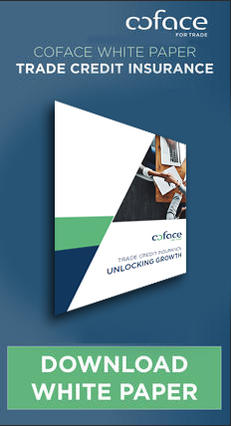Navigating the Economics of Agrifood in 2023 and Beyond

In partnership with the Association of Food Industries, Inc. (AFI), Coface North America Economist Ruben Nizard and Senior Risk Underwriter Derek Baldwin shared macro and micro economic outlooks for the agrifood industry in 2023, discussing the latest industry trends and ways businesses can mitigate risk to support growth using trade credit insurance. You can watch the full replay here.
Over the last three years, global industries have been on a rollercoaster ride experiencing impacts from the pandemic, changing political headwinds, and the upheaval from the war between Ukraine and Russia. These themes have dominated both watercooler and economic discussions and may continue to do so as effects reverberate across nearly every sector. Some industries, however, have the unique quality of providing essential goods and services, allowing businesses who implement smart strategic approaches to remain above the fray in uncertain times. Agrifood is one such industry.
Right now, for businesses in the agrifood space, the question becomes:What are the challenges to developing a strong business strategy, and how can businesses avoid succumbing to those challenges to maintain a competitive advantage in 2023 and beyond?
To answer this question, Coface North America Economist Reuben Nizard and Senior Risk Underwriter Derek Baldwin share conditions in the global and U.S. economies and agrifood industry that every agrifood business should understand to develop a resilient business strategy. You can catch a full replay of their conversation here.
The Global Economic Outlook Impacting Agrifood
After the global economic rebound from the COVID-19 pandemic, 2022 ushered in the start to a large-scale economic slowdown prompted by Russia’s invasion of Ukraine and swiftly increasing inflation. As a result, in 2023, global economic growth is anticipated to slow to 2 percent – a decline only seen four times in economic history (2001, 2008, 2009 and 2020).
Most of the macroeconomic growth that will be seen in 2023 will be in Emerging Markets and with commodity exporters of minerals, agriculture and energy. “In fact, China and India will account for half of this year’s global activity,” says Nizard.
This means advanced economies will drive most of the slowdown. “Europe will face the impacts of Ukraine being cut-off from Russian gas, and high inflation caused by tighter monetary policies will continue to create economic burden in the U.S, as well,” he shares.
While inflation in the U.S., which reached a 40-year high of 9.1 percent in mid-2022, has eased, the Federal Reserve’s 2 percent inflation target is unlikely to be met anytime soon.
To counteract high inflation, Nizard says the U.S. Central Bank raised interest rates aggressively in an effort to “bring balance back to supply and demand.” These restrictive rates are contributing to sluggish economic activity.
“What is helping to keep the U.S. economy from narrowly avoiding a recession this year is consumer spending accounting for two-thirds of GDP, supported by a strong labor market coupled with a cushion of savings accumulated in 2020 and 2021” explains Nizard. While manufacturing and real estate see further declines from interest rate hikes, “consumer services and essential products like food remain resilient.”
One area that threatens continued consumer and business spending though is increased turmoil in the banking industry. Tighter credit conditions triggered by restrictive monetary policies, and which will likely be amplified by recent developments in the banking industry are lowering demand. In this context, a return to pre-pandemic levels of bankruptcies and insolvencies can be expected in 2023.
Overall, this means the risk profile for the agrifood industry is medium.
“What’s a bit different now for the industry is we have these worries that are being heightened with the fears of the situation unfolding in Ukraine. Russia and Ukraine account for a major portion of agrifood commodities. In 2021, they provided one-third of the world wheat exports and one-half of sunflower oil exports.”
Despite efforts like the Black Sea Agreement’s attempt at easing some supply chain issues, Russia’s role as a main supplier for both food and energy commodities will keep prices high. Farmers are having to deal with these price increases on commodity inputs during a difficult farm industry labor shortage and increased wage demand. The costs pressures on producers will remain throughout the year, but long-term consumer trends show specialty and exotic non-processed food (nuts and vegetables) and beverage products will continue to increase.
This balancing act between supply chain and consumer need means “agrifood businesses will need to develop a resilient risk strategy to combat ongoing tightened monetary policy effects, banking credit issues and the war in Ukraine,” says Nizard.
Creating an Agrifood Risk Strategy for Success
The agrifood industry is seeing challenges rarely suffered prior to the pandemic. “Claims are up 60 to 70 percent year over year prior to 2020,” says Baldwin. However, agrifood businesses can protect themselves against rising late payments, overdue credit accounts, inflation impairing margins, supply chain costs and cash flow issues by implementing smart risk strategy. “The most effective way to implement risk strategy is by obtaining trade credit insurance,” explains Baldwin.
“Trade credit insurance is a safe-guarding tool. It secures existing sales and provides guidance on growing business by analyzing macro and micro economic conditions, company history, ownership background, business portfolios, customers, payment and trade trends, trade accounts, financials and credit risk.”
Trade credit insurance from Coface can provide these analyses. Information such as how grocers are passing inflation costs to consumers to sustain agrifood markets; how the beverage subsector would be seeing revenue declines if it weren’t for price increases between 10 to 15 percent year over year; and how casual dining isn’t able to pass along costs because businesses must maintain an appetizing value proposition to get customers in the door repeatedly to stay competitive.
Additionally, Coface’s data on trends like agrifood imports can strategically guide agrifood businesses pipeline efforts. Baldwin says “consumers are relying on import products that outweigh production in-country.” In the U.S., imports account for 15 percent of the overall food supply, and this will only increase as the country’s population becomes wealthier and more ethnically diverse.
As the agrifood industry tries to stay steady this year, businesses will be better poised to use that steadiness if they can “better understand the outside influences pressuring the sector and getting ahead of increasing payment issues,” says Baldwin.
“Companies that use trade credit insurance will be able to more effectively maintain their margins and profitability because they’ll have access to key in-depth analysis that can help them make smarter business strategy and development decisions, driving growth in 2023 and beyond.”
***
Learn more about Coface trade credit insurance and follow Coface North America economist Ruben Nizard on LinkedIn.








